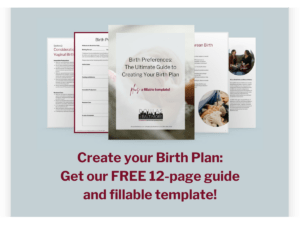Nausea in the first trimester is pretty common. From strangers at the store to your family members, you’ll often hear, “Are you having morning sickness?”
A misnomer, many pregnant people are shocked to find that their “morning sickness” hits at lunch time or persists into the evening. Accompanying every interaction is likely to be a reassuring “At least it’s almost over! A few more weeks and you’ll feel much better!”
However, the truth is a little more complicated than that.
Why isn’t this nausea going away?
For some with “morning sickness”, they will indeed find that it resolves as they enter the second trimester. On the other hand, some will experience nausea that continues for the duration of the pregnancy. Alternatively, many will find that it fades for months and returns in the third trimester.
Usually the reappearance of nausea is benign and does not signal a cause for concern. Since late nausea may be a sign of Preeclampsia we still recommend discussing any new symptoms with a trusted healthcare provider.
Please note that this blog covers typical nausea or “morning sickness”, and not the more serious Hyperemesis Gravidarum. HG occurs in up to 3% of pregnancies. If you suspect you have HG we recommend contacting your provider immediately to receive care for this severe form of nausea, dehydration, and weight loss.
Third trimester nausea: Cameron’s story
Cameron experienced nausea in late pregnancy. A mother of three, she had routine first trimester morning sickness with all three pregnancies, which faded away with the first two babies by 16 weeks. With the third pregnancy, however, she had some memorable bouts with nausea in the last 5 weeks before delivery.
“I was so tired all the time, with two young children at home and a traveling husband. I wasn’t taking time to eat well or to sit and put my feet up, so I shouldn’t have been surprised one morning when I had to bolt for the front door and throw up in the bushes.”
Her next unexpected attack was the following week, at Christmas at her mother’s house. With so much going on and a crowded house full of relatives, she and her husband were sharing a bathroom. “He farted in there, and the whole house heard me throw up. Funny in hindsight, but it wasn’t pretty at the time!”
Cameron said she frequently felt queasy during those weeks, and struggled to find enough to eat to fuel her body and combat the fatigue that built every afternoon. In her 36th week she caught a stomach virus. After 3 days of struggling to keep anything down, IV fluids and anti-nausea medication were administered.
Despite the extreme nausea Cameron’s baby was born healthy at 38 weeks after an induction for hypertension, and the nausea disappeared.
What if you find yourself in Cameron’s shoes?
Identifying causes may be helpful so that you can target your treatment, but many times the cause is a combination of hormones and the physical changes when growing a baby. If this is the case, there are many coping strategies but the only real “cure” is birth!
Keep a Food/Supplement Journal
Writing down what you eat for a period of time can be an excellent way to find patterns in your eating and when they correlate with nausea. Additionally, some people find that their supplements (such as a prenatal vitamin) make them feel sick. If this is the case, try taking your supplements in the evening.
Drink Water!
Are you staying well hydrated? Dehydration can worsen your nausea symptoms and, if you are actually vomiting, you’ll be losing a lot of fluids needed for your body functions. Try keeping a refillable water bottle near you full of ice water so it’s easy to remember.
Try Snacks or Smaller Meals
Eating smaller amounts of food more frequently could help keep nausea under control. Part of the reason this works is because it keeps your blood sugars stable. Try making sure each snack or meal has some high quality carbs and protein to assist in balancing the sugars.
On the other hand, if all you can stomach is cereal, eat cereal. Fed is best for you, too.
Buy Yourself Some Candy
Ginger and peppermint have long been touted as helpful things to combat a queasy stomach. There are hard and soft versions of these candies, though many pregnant individuals swear by sucking on hard candies. Alternatively, sour candies have been reported as helpful too.
Above all, finding some time to rest is helpful for coping with nausea, and is also an essential component of preparing yourself for labor. When in doubt, reach out to your doula for suggestions or to discuss steps you can take. Remember, it will end! Until then, you’re doing great hanging in there.


